| TL;DR
Zero waste management aims to eliminate waste, not just manage it. |
|---|
The world generates over 2 billion tons of waste each year, and landfills and oceans are struggling to keep up. Zero waste management offers a smarter solution; focusing on waste prevention, reuse, and resource recovery to protect human health, conserve natural resources, and reduce climate impact.
In this blog, we’ll cover the core principles of zero waste, practical tips for daily life and organizations, real‑world zero waste examples, and how embracing a zero waste lifestyle can create a cleaner, sustainable future.
What Is the Zero Waste Concept?
The zero waste concept reimagines waste not as trash, but as a valuable resource. Instead of the traditional linear system, which includes take, make and dispose, zero waste encourages a loop, where materials are reused or naturally reintegrated.
The definition of zero waste, as stated by the Zero Waste International Alliance, is “the conservation of all resources by means of responsible production, consumption, reuse, and recovery of products and materials without burning and with no discharges to land, water, or air.”
What Is Zero Waste Management System?
A zero waste system refers to an integrated approach that manages discarded materials to prevent them from becoming waste. It involves product redesign, behavioral change, and systems-level transformation.
The features of zero waste management is based on:
- Waste prevention at the source
- Material recovery through recycling and composting
- Emphasis on producer responsibility
- Continuous improvement and community education
What Is the Importance of Going Zero Waste for the Planet?
The planet is under pressure from waste generation, natural resource depletion, and rising greenhouse gas emissions. Going zero waste helps:
- Reduce climate impact by limiting methane from landfills.
- Conserve raw materials and avoid resource extraction.
- Protect human health by minimizing the toxicity of waste.
Greenworksbio contributes by replacing plastic with compostable alternatives, reducing your carbon footprint and supporting sustainable natural cycles.
What Are the Key Goals of Zero Waste for Communities and Businesses?
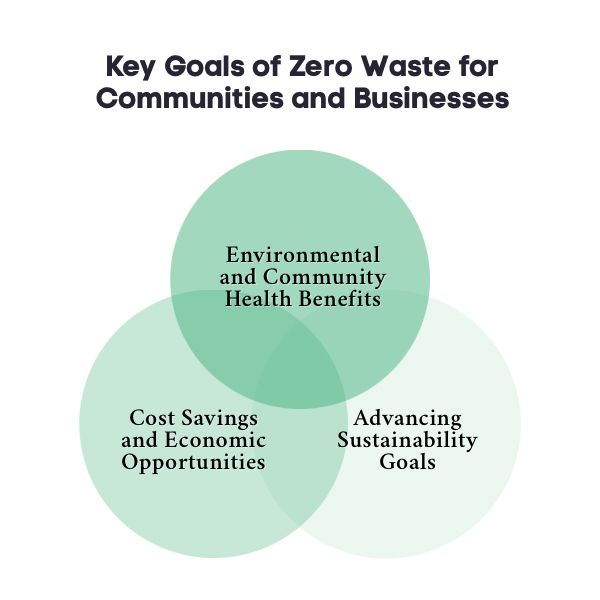
The goal of zero waste goes beyond reducing trash; it’s about creating sustainable systems that benefit both the environment and the economy. By aligning with the concept of zero waste, communities and businesses can reduce pollution, protect human health, and contribute to the circular economy.
1. What Are the Environmental and Community Health Benefits of Zero Waste?
According to recent findings, zero waste strategies can reduce total emissions from the waste sector by up to 84%, which is equivalent to removing the annual emissions of 300 million cars. Adopting zero waste strategies has a direct positive impact on the environment and public health:
- Cleaner air and water: Less burning and landfilling reduces greenhouse gas emissions and contamination of waterways.
- Safer waste handling: Proper waste management practices minimize exposure to harmful chemicals and reduce the toxicity of waste.
- Reduced plastic pollution: Limiting single-use plastics protects wildlife and decreases long-term environmental harm.
- Less dependency on landfills and incinerators: Shifting toward resource recovery and waste prevention helps preserve land and cut climate impact.
These efforts create zero waste communities that are healthier, more resilient, and safer for future generations.
2. How Does Zero Waste Create Cost Savings and Economic Opportunities?
Zero waste isn’t just an environmental initiative, but it also makes financial sense:
- Efficient waste management practices: Sorting, reusing, and recycling reduce landfill fees and optimize material flows.
- Job creation in material recovery and recycling: Developing resource recovery systems and product redesign initiatives boosts local employment. For instance, the recycling and reuse sector supports around 681,000 jobs, contributes $37.8 billion in wages, and generates $5.5 billion in tax revenues, according to the EPA’s 2020 Recycling Economic Information Report.
- Support for local economies: Community initiatives like refill stations, repair shops, and composting services drive local economies and encourage sustainable consumption.
Businesses that implement zero waste systems often achieve continuous improvement, turning discarded materials into new products and revenue streams.
3. How Does Zero Waste Help Businesses and Communities Advance Sustainability Goals?
Zero waste adoption positions businesses and communities as leaders in environmental responsibility:
- Lower operational costs: Reduction of waste leads to fewer raw material purchases and lower disposal fees.
- Compliance with extended producer responsibility regulations: Meeting producer responsibility requirements helps avoid penalties and aligns with government policies.
- Enhanced brand image: Using zero waste products like certified compostable packaging demonstrates commitment to sustainable natural cycles and strengthens consumer trust.
By integrating zero waste strategies into own operations and supply chains, organizations not only reduce their carbon footprint but also contribute to the progression of policies promoting responsible production and consumption.
Looking to ditch single-use plastics? Discover 8 smart packaging alternatives you can switch to today!
What Are the Fundamental Principles of Zero Waste? The 5 R’s
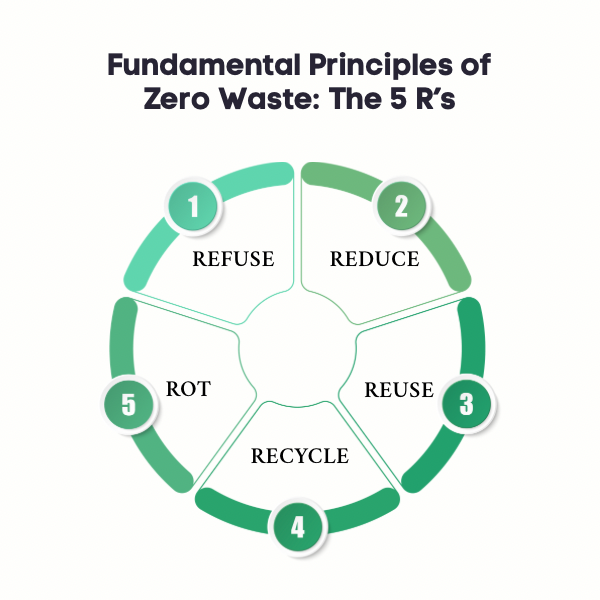
The goal of zero waste is to conserve resources, reduce pollution, and move toward a circular economy. This mission is best understood through the 5 R’s framework, which prioritizes preventing waste at its source before managing what remains.
1. Refuse – What Can You Say No To?
The first step is simple but powerful: say no to what you don’t need. This includes single-use plastics, excessive packaging, and items that can’t be reused, recycled, or composted. By refusing waste before it enters your home, workplace, or supply chain, you reduce the burden on the system right from the start.
2. Reduce – What Can You Use Less Of?
Next, aim to cut back on what you do use. Focus on essentials, streamline your purchases, and choose well-designed, long-lasting products. Reducing not only lowers waste but also minimizes your environmental footprint by conserving energy, water, and raw materials throughout the product lifecycle.
3. Reuse – How Can You Extend the Life of Products?
Before throwing something away, ask: can this be used again? Whether it’s a glass jar repurposed for storage, a cloth bag replacing disposables, or a repaired appliance given new life, reusing extends the value of materials and keeps them out of the waste stream for longer.
4. Recycle – Are You Maximising Material Recovery?
When items reach the end of their usefulness, recycling helps recover their raw materials. But it should come after refusing, reducing, and reusing. Recycling uses energy and has limits, so focus on doing it correctly: separate materials properly, know your local recycling rules, and avoid contaminating the stream with non-recyclables.
5. Rot – Are You Managing Organic Waste Responsibly?
Finally, embrace the power of composting. Organic waste like food scraps, coffee grounds, and garden trimmings don’t belong in landfills; they can be transformed into nutrient-rich compost. This not only nourishes the soil but also reduces methane emissions and supports the natural regeneration cycle.
How Does the Zero Waste Hierarchy Work?
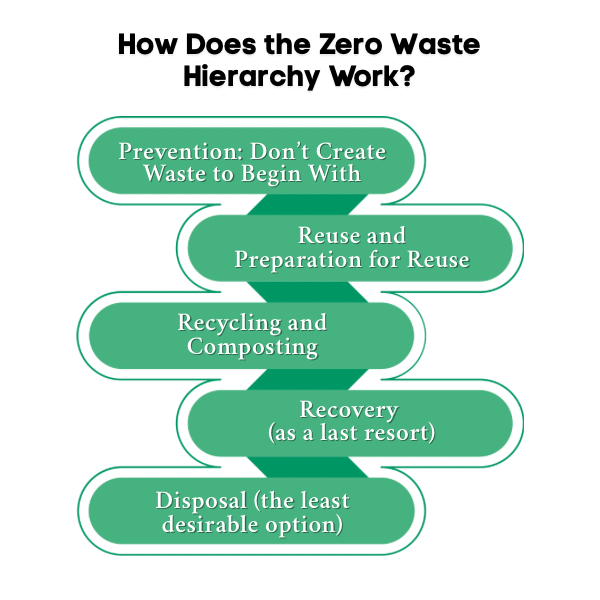
The Zero Waste Hierarchy is more than just a list of how to get rid of waste; it’s a mindset shift. It helps individuals, businesses, and governments focus on upstream solutions that prevent waste from being created in the first place, rather than just figuring out what to do with it afterward.
It follows a clear order of priority, from most to least sustainable, guiding decisions toward long-term, circular solutions.
1. Prevention: Don’t Create Waste to Begin With
This is the top priority: eliminate waste before it’s even made. That means choosing minimal or no packaging, designing longer-lasting products, and rethinking production systems. For example, offering digital receipts instead of paper, or selling in bulk instead of single-use packs.
2. Reuse and Preparation for Reuse
If something can be reused, don’t throw it away. Refill a bottle, repair a gadget, or donate a product. Businesses can set up return schemes, and consumers can opt for reusable containers and bags. The goal is to extend product life as much as possible.
3. Recycling and Composting
If an item can’t be reused, the next best thing is to recycle or compost it. This includes separating paper, plastics, metals, and certified compostable materials for proper processing. It’s not a perfect system, but it helps recover valuable materials and diverts waste from landfills.
4. Recovery (as a last resort)
If materials can’t be recycled or composted, energy recovery might be considered. This includes anaerobic digestion or controlled incineration to recover energy. However, it’s important to note: recovery is not a green light for single-use; it’s simply better than landfill.
5. Disposal (the least desirable option)
Landfilling or open burning is the very bottom of the hierarchy. These methods waste resources, pollute the environment, and should only be used when no other option exists. The zero waste goal is to avoid reaching this step altogether.
How Can You Implement Zero Waste in Daily Life?
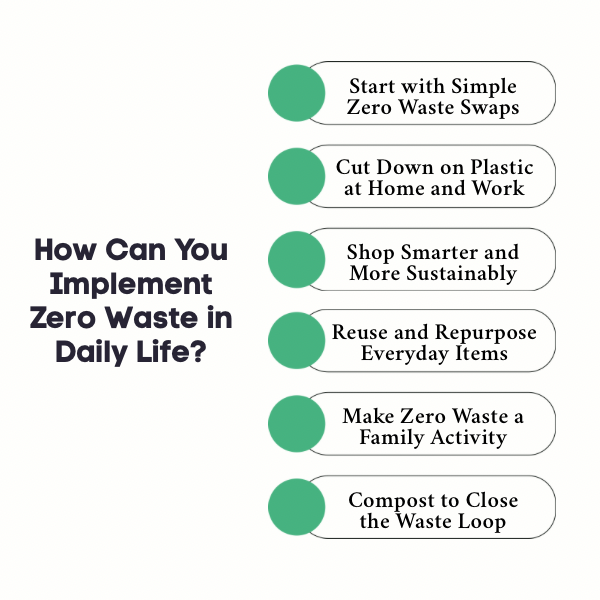
Shifting to a zero waste lifestyle starts with small, intentional changes that gradually reduce your environmental footprint. By making simple swaps, rethinking daily habits, and involving your family, you can prevent waste from entering landfills and contribute to a sustainable circular economy.
1. What Are Some Simple Zero Waste Swaps to Start With?
Making small replacements in your daily routine is the easiest way to start:
- Use cloth napkins instead of disposable paper towels.
- Choose metal straws over single-use plastic straws.
- Switch to shampoo bars instead of plastic bottles.
These swaps not only reduce waste generation but also save money over time.
2. How Can You Reduce Plastic Use at Home and Work?
Plastic pollution is a major barrier to achieving the goal of zero waste. Minimize plastic consumption by:
- Using zero waste biodegradable or certified compostable products from Greenworksbio.
- Choosing refillable cleaning and toiletry products.
- Avoiding individually wrapped items wherever possible.
Switching to eco-friendly packaging ensures waste is managed responsibly and aligns with sustainable natural cycles.
3. How Can You Shop More Sustainably to Avoid Waste?
Shopping choices directly impact your waste footprint. You can reduce waste by:
- Buying in bulk to avoid excessive packaging.
- Supporting local refill stores and farmers’ markets.
- Avoiding large quantities of non‑recyclable packaged goods.
Supporting local economies through sustainable shopping strengthens community efforts toward waste reduction.
4. How Can You Reuse and Repurpose Everyday Items?
Before discarding items, consider how they can be reused:
- Turn glass jars into planters, spice containers, or craft holders.
- Upcycle old clothes into cleaning rags or cushion stuffing.
- Repurpose packaging into storage or DIY projects.
This approach aligns with the reuse of materials principle in the zero waste hierarchy.
5. How Can You Involve Your Family in Zero Waste Practices?
Creating a zero waste community starts at home:
- Educate children about waste prevention through fun activities.
- Make recycling and composting a game to encourage participation.
- Track household progress to stay motivated.
Family involvement fosters long-term behavioral change and inspires others in your neighborhood.
6. What is the Role of Composting in a Zero Waste Lifestyle?
Food waste is one of the largest contributors to solid waste management challenges. Home composting helps by:
- Turning organic matter into nutrient-rich compost for gardens.
- Reducing landfill waste, which prevents methane and hydrogen sulfide emissions.
- Supporting sustainable natural cycles and resource recovery.
Whether you use a simple bin or adopt anaerobic digestion solutions, composting is key to achieving true zero waste at the household level.
Want to make your packaging eco‑friendly? Explore 8 sustainable materials that lead the change!
How Can Organizations and Institutions Adopt Zero Waste Practices?
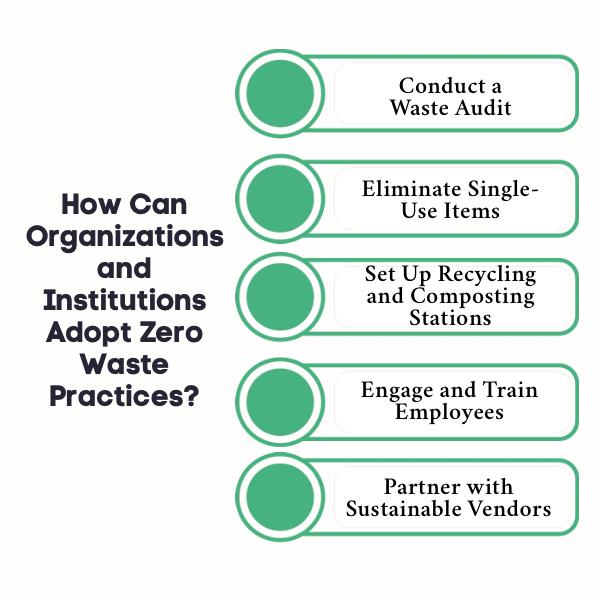
Adopting zero waste practices in organizations and institutions requires a structured approach across internal operations and supply chains. From offices to factories, these strategies cut environmental impact and boost resource efficiency. Below are five key steps to get started.
1. Conduct a Waste Audit
Start by identifying where waste is generated across your facility. Examine solid waste streams, track material flows, and classify waste into categories like paper, plastics, organic matter, and electronic waste. A waste audit provides the baseline data needed to set reduction goals and measure progress over time.
2. Eliminate Single-Use Items
Single-use plastics, paper cups, and disposable packaging are major contributors to waste generation. Replacing single-use plastics with reusable alternatives or certified compostable options significantly cuts waste at the source. This also encourages employees and customers to adopt sustainable habits.
3. Set Up Recycling and Composting Stations
Creating clearly labeled recycling and composting points makes resource recovery seamless. Set up recycling and composting stations in high-traffic areas, provide guidance on proper segregation, and ensure collected materials are regularly sent to verified recycling or composting facilities to avoid contamination.
4. Engage and Train Employees
People are central to the success of a zero waste community. Conduct workshops, create internal challenges, and set measurable goals to increase engagement. Employee participation ensures behavioral change becomes part of daily routines rather than a short-term initiative.
5. Partner with Sustainable Vendors
Work with suppliers who align with means of responsible production and sustainable sourcing. Prioritize vendors offering recyclable, compostable, or reusable materials, and consider extended producer responsibility programs that take back packaging or products at end-of-life.
What Are the Common Barriers to Adopting Zero Waste Management?
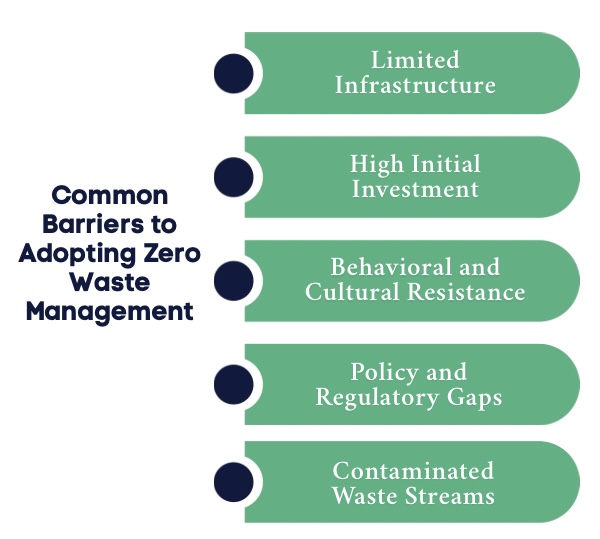
Transitioning to zero waste management can transform communities, but several barriers often slow down adoption. Understanding these challenges is the first step toward building effective, long‑term solutions.
1. Limited Infrastructure
Many cities lack adequate recycling, composting, and resource recovery facilities, which are critical for handling diverse waste streams. In rural or underfunded areas, the absence of proper collection and processing systems makes waste diversion and material recovery highly challenging.
2. High Initial Investment
Setting up a zero waste system involves significant upfront costs for waste audits, composting stations, collection units, and educational programs. Smaller municipalities or community projects often struggle to secure the necessary funding for these infrastructure improvements.
3. Behavioral and Cultural Resistance
Shifting from a linear system of take‑use‑dispose to a circular economy requires a mindset change. People must adopt habits like reducing single‑use plastics, segregating waste at source, and reusing materials. These practices take time and consistent community engagement to normalize.
4. Policy and Regulatory Gaps
The absence of strong extended producer responsibility (EPR) frameworks and insufficient local waste reduction policies can slow progress. Without clear guidelines, incentives, and enforcement, achieving the goal of zero waste becomes much harder for both businesses and residents.
5. Contaminated Waste Streams
Even with infrastructure in place, improper segregation, such as mixing food waste with recyclables, can lower the efficiency of material recovery. Contamination not only drives up processing costs but can also render large portions of waste unusable for recycling or composting.
What Are Some Noteworthy Real-World Examples of Zero Waste Cities and Projects?
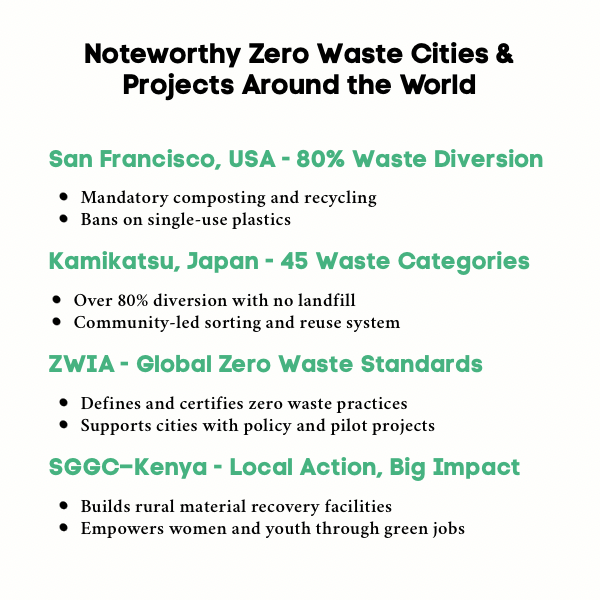
Zero waste examples worldwide illustrate how cities, communities, and companies are turning sustainability goals into reality. Through a mix of forward‑thinking policies, innovative waste management practices, and active community engagement, these initiatives prove that the journey toward true zero waste is both achievable and impactful.
1. San Francisco, United States
San Francisco is a global leader in urban zero waste initiatives, achieving an impressive 80% landfill waste diversion rate through mandatory composting and recycling programs, bans on single-use plastics, and extended producer responsibility policies.
The city’s integrated approach combines strong legislation, public education, and infrastructure investment to minimize landfill reliance and support circular waste systems.
2. Kamikatsu, Japan
This rural town of around 1,500 residents has become a global model for grassroots-led zero waste living. Kamikatsu requires households to separate waste into 45 distinct categories for recycling and reuse.
With no landfill or incinerator, the town has achieved over 80% waste diversion. Its success comes from strong community cooperation, a dedicated reuse shop, and ongoing education programs to reduce consumption.
3. Zero Waste International Alliance (ZWIA)
ZWIA defines zero waste principles and sets certification standards that guide cities and organizations toward sustainable materials management.
ZWIA supports pilot projects, policy development, and research across continents, making it a backbone for cities pursuing zero waste transformations through verified frameworks.
4. SGGC‑Kenya (Sustainable Green Growth Center)
SGGC‑Kenya works with rural communities to promote zero waste and circular economy models. Their initiatives include setting up local material recovery facilities, running awareness campaigns on responsible consumption, and empowering women and youth in green jobs.
SGGC integrates health, climate, and livelihood goals, making zero waste part of broader sustainable development strategies in East Africa.
How Can We Promote Zero Waste Living in India?
India faces a significant waste challenge, generating over 62 million tons annually (source). Rapid urbanization, increasing consumption, and limited waste management infrastructure have led to overflowing landfills, rising greenhouse gas emissions, and growing environmental risks.
Embracing a zero waste lifestyle in India involves not only individual action but also systemic change across businesses, communities, and industries. It requires rethinking how products are designed, distributed, and disposed of, while encouraging local participation and sustainable solutions.
Key actions include:
- Encouraging industrial designers to adopt sustainable materials.
- Shifting supply chain policies toward compostable solutions.
- Raising awareness at the local level through community initiatives.
Get inspired with these creative, eco‑friendly packaging ideas that truly make an impact!
Greenworksbio – Powering Your Zero Waste Journey
Transitioning to zero waste management doesn’t have to be overwhelming. At Greenworksbio, we help businesses and communities bridge the gap between intention and action with:
- Certified compostable packaging that supports circular economy goals
- Eco‑friendly solutions that reduce plastic pollution and support resource recovery
- Scalable options for hospitality, retail, and supply chains aiming for true zero waste
By replacing single‑use plastics with compostable alternatives, you not only minimize waste generation but also contribute to the conservation of natural resources and a healthier planet for future generations.
Start your zero waste journey today with Greenworksbio, where sustainability meets performance. Contact us today!
Moving Toward a True Zero Waste Future
Zero waste management is not just an eco-friendly trend; it is a critical solution to global waste and climate challenges. By reducing discarded materials, protecting natural resources, and preventing pollution, we secure a healthier planet for future generations.
Every small change, from adopting the 5 R’s to community-wide initiatives, contributes to meaningful impact. With collective effort, zero waste can move from an inspiring concept to a sustainable reality that benefits both people and the planet.
Frequently Asked Questions
What Is the Zero Waste Management Theory?
Zero waste management theory is a holistic approach that focuses on redesigning production and consumption systems to prevent waste entirely. It emphasizes closed-loop cycles, sustainable natural cycles, and continuous resource recovery, ensuring materials remain in use without polluting air, water, or land.
What Is a Zero Waste Society?
A zero waste society is one where individuals and communities adopt sustainable practices, from household waste segregation to city‑wide composting programs. Cities like San Francisco, with an 80% landfill diversion rate, prove that large‑scale impact is achievable.
What Are Zero Waste Biodegradable Alternatives?
A zero waste biodegradable product is one that naturally decomposes without leaving behind harmful microplastics. Options like certified compostable packaging from Greenworks Bio reduce plastic dependency and support a circular economy by safely returning materials to nature.
What Is the Hardest Part About Going Zero Waste?
The hardest part is shifting from convenience to conscious living. It requires breaking long-standing habits, consistently refusing unnecessary items, and embracing sustainable alternatives while committing to the lowest use of materials across home, work, and community settings.
What Should I Buy to Go to Zero Waste?
Focus on zero waste products such as reusable cutlery, refillable bottles, compostable trash bags, and bulk storage containers. Prioritize durable items and biodegradable alternatives, which help reduce single-use waste and align with a sustainable, circular lifestyle that supports zero waste goals.
What Are the 5 Rules of Zero Waste?
The 5 rules are Refuse, Reduce, Reuse, Recycle, and Rot. These guide individuals and businesses to prevent waste, conserve natural resources, and promote sustainable cycles, forming the core concept of zero waste as defined by the Zero Waste International Alliance.

